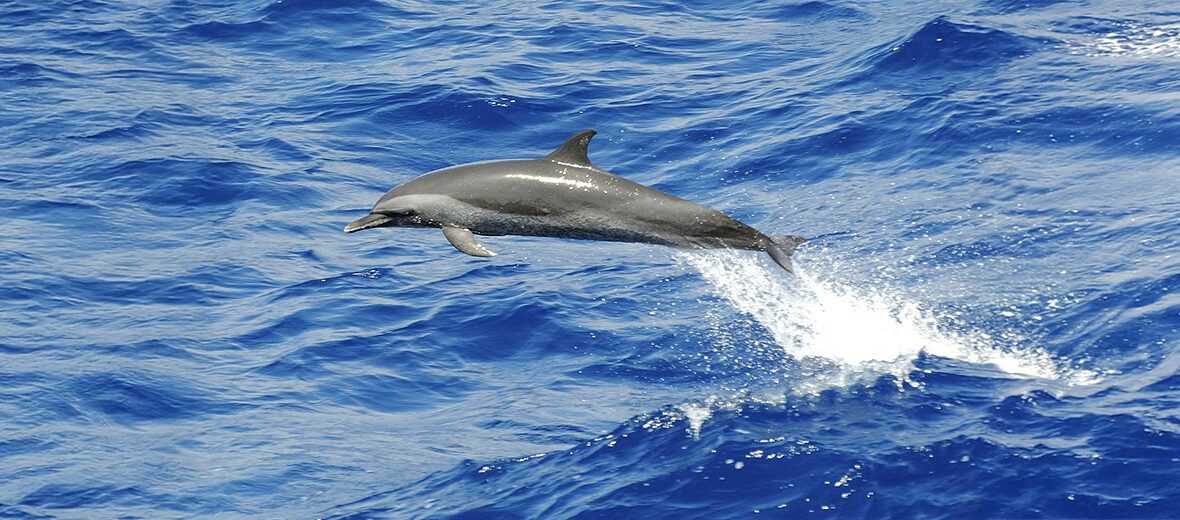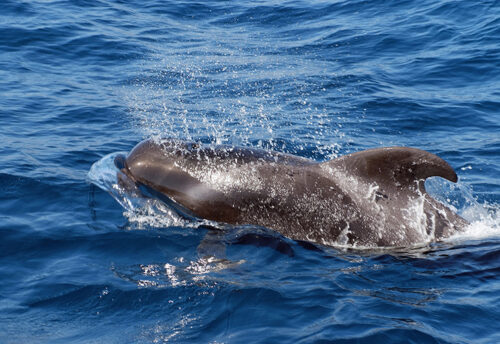
The Pantropical spotted dolphin can be found in all the world’s temperate and tropical oceans. These dolphins were starting to decline rapidly before the 1980s due to millions of them being killing in tuna purse seine nets. But thanks to “dolphin safe” practices, millions have been spared. They currently face the threat of overfishing. However, Pantropical spotted dolphins are abundant enough to be listed as Least Concern by the IUCN. Their population trend is listed as unknown though.
First the Stats…
Scientific name: Stenella attenuata
Weight: Up to 262.35 lbs.
Length: Up to 8.2 feet
Lifespan: Up to 46 years
Now on to the Facts!
1.) These dolphins were originally described by John Gray in 1846. However, Gray’s initial analysis included the Atlantic spotted dolphin in this species, and the Atlantic spotted dolphins are a separate species.
2.) There are 2 subspecies recognized: S. a. attenuata, aka offshore pantropical spotted dolphin, located worldwide in tropical waters and the S. a. graffmani, aka coastal pantropical spotted dolphin, located in coastal waters in the eastern tropical Pacific Ocean.
3.) These critters vary dramatically in size and coloration throughout their range. The most profound division is between coastal and pelagic varieties. The coastal forms are larger and more spotted.
4.) Juveniles are more uniformly colored and thus often mistaken for bottlenose dolphins. Not until they reach adulthood do they acquire their spots.
5.) These dolphins are very active and prone to engaging in large leaps followed by big splashes from the sea. They are a common breaching dolphin and will often clear the water for 1 or more seconds. Bow-riding and other play with boats is commonplace.
But wait, there’s more on the Pantropical spotted dolphin!
6.) In the eastern Pacific, these dolphins are often found swimming along with yellowfin tuna (hence the issues with dolphin deaths caused by tuna fishing). However, they don’t feed on tuna, as both species feed on the same prey.
7.) Numerous supermarkets found it economically prudent to use tuna suppliers whose fisherman catch tuna by more cautionary means, and thus advertise their tuna products as “dolphin-friendly”. Some of these products are approved by the Whale and Dolphin Conservation Trust.
Did you know…?
Over a time frame of about 25 years, 75% of the Pacific population of Pantropical spotted dolphins, and over half the world’s total population of them were eliminated.
8.) Instead of reducing numbers through direct deaths, fishing activities have disrupted the reproductive output of northeastern pantropical spotted dolphins. The fishing has had a negative impact on calf survival rates and/or birth rates. This might be caused by fishing operations separating mothers from their suckling calves, interfering with the conception or gestation of calves, or a combination of both.
9.) Females undergo up to an 11 month gestation (pregnancy) that yields a single calf.
10.) Weaning can take up to 2 years, but at 3 – 6 months juveniles will begin eating solid foods.
But wait, there’s still more on the Pantropical spotted dolphin!
11.) Smaller schooling fish, squid, and octopus are all on the menu.
12.) Orcas and sharks prey on these dolphins.
13.) In general, dolphin deaths have dramatically reduced since the establishment of the Inter-American Tropical Tuna Commission (IATTC). The Commission set mortality limits on the international fleet. In 2005, an estimated 373 spotted dolphin deaths were reported.
14.) Dolphin populations are typically able to grow at 4% per year, however the pantropical spotted dolphin populations did not improve or worsen between 1979 – 2000. The population has not recovered, even though a 30 year species management has been in effect.
Now a Short Pantropical Spotted Dolphin Video!
Be sure to share & comment below! Also, check out the Critter Science YouTube channel. Videos added regularly!
Want to suggest a critter for me to write about? Let me know here.
Some source material acquired from: Wikipedia & IUCN
Photo credit: Marilia Olio




